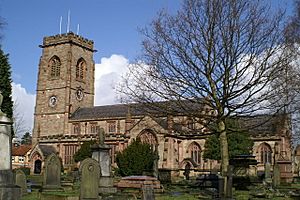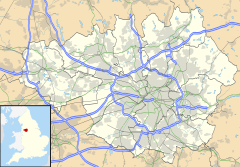Bowdon, Greater Manchester facts for kids
Quick facts for kids Bowdon |
|
|---|---|
 Bowdon Parish Church |
|
| Population | 9,228 (2011) |
| Metropolitan borough | |
| Metropolitan county | |
| Region | |
| Country | England |
| Sovereign state | United Kingdom |
| Post town | ALTRINCHAM |
| Postcode district | WA14 |
| Dialling code | 0161 |
| Police | Greater Manchester |
| Fire | Greater Manchester |
| Ambulance | North West |
| EU Parliament | North West England |
| UK Parliament |
|
Bowdon is a lovely suburb located near Altrincham in Greater Manchester, England. It's known for its beautiful homes and green spaces.
Contents
History of Bowdon
Bowdon has a long history! It was even mentioned in the Domesday Book, a famous survey from 1086. This old book tells us there was a church and a mill here a very long time ago.
The name Bowdon comes from old Anglo-Saxon words. It means "bow-hill" or "curved hill," probably describing the shape of the land.
Castles and Old Families
In Norman times, a powerful family called the de Mascys owned Bowdon and nearby Dunham Massey. Their main home was a wooden castle at Dunham. Another castle, Watch Hill Castle, was built between Bowdon and Dunham Massey. It was also made of timber and likely belonged to the de Mascys. This castle was no longer used by the 1200s.
Later, in 1750, the lands passed to the Earl of Stamford. The last Earl of Stamford passed away in 1976. He gave Dunham Massey and other estates to the National Trust. This means these important places are now looked after for everyone to enjoy.
How Bowdon Grew
Bowdon started to grow a lot in the 1840s. Landowners began selling parts of their land. A new Bowdon railway station opened in 1849. This made it easy for people to travel to Manchester for work. Many wealthy business owners, sometimes called 'merchant princes,' built large, fancy houses here. They loved the fresh air and peacefulness of Bowdon Downs.
By 1878, Bowdon was described as being "full of handsome villas and mansions." Most residents were business owners. Modern services like mains water arrived in 1864, and gas lighting by 1865.
Interesting Historical Facts
The Altrincham History Society shares some cool facts about Bowdon:
- An old stone from 1840 marks the boundary between Altrincham and Dunham Massey. You can still see it in a garden wall!
- The area called The Devisdale was once a common land. In 1644, during the Civil War, 10,000 soldiers camped here.
- The Altrincham Show, a big farming event, used to be held on The Devisdale until 1966. Farmers from all over the country came to show their animals.
Local Government
From 1894 to 1974, Bowdon had its own local government. It was called an Urban District. This meant it managed its own local services.
Since 1974, Bowdon has been part of the Metropolitan Borough of Trafford. It is an electoral ward, which is like a local area for voting.
Geography
Bowdon is located on the southwest edge of Greater Manchester. It sits on a ridge, which is like a raised line of land, overlooking the Cheshire Plain. Bowdon is the largest ward in Trafford. It has small, quiet villages and open countryside.
Many people think Bowdon is a very nice and wealthy place to live.
A large part of Bowdon is owned by the National Trust. This includes the Dunham Massey Hall and a large deer park. These areas are important green spaces for everyone in the community. Bowdon is a semi-rural area, meaning it has a mix of countryside and homes, and not too many people live very close together.
Parts of Bowdon
Bowdon is made up of four main neighborhoods:
- Dunham Massey
- Warburton
- Bowdon (the main village)
- Bowdon Vale
People of Bowdon
In 2001, about 8,806 people lived in Bowdon. Around 1,730 were under 16 years old, and 1,699 were 65 or older. Most residents described themselves as white.
Bowdon is considered one of the wealthiest areas in the UK. This means that people living here generally have good jobs and comfortable lives. Over the years, more people with professional jobs have moved to Bowdon.
Education
Bowdon has both state-funded and independent schools.
State Schools
- Bollin Primary School
- Bowdon CE Primary School
- Altrincham Grammar School for Girls, Cavendish Road, Bowdon
- Altrincham Grammar School For Boys, Marlborough Road, Bowdon
Independent Schools
- Altrincham Preparatory School, Marlborough Road, Bowdon.
- Bowdon Preparatory School, Stamford Road, Bowdon.
Religion
Bowdon Parish is part of the Anglican Diocese of Chester. The main church, St Mary the Virgin, can be easily seen from the Cheshire Plain.
Bowdon Vale Methodist Church has also been in the area since 1883.
Fun and Games
There are many places for leisure and recreation in Bowdon:
- Dunham Massey – This beautiful estate, now owned by the National Trust, has a grand mansion, lovely gardens, and a deer park. It's a great place to visit!
- Bowdon Cricket Club, Hockey and Squash Club
- Bowdon Vale Cricket Club – This club started in the 1870s.
- Bowdon Rugby Union Football Club – Founded in 1877.
- Bowdon Lawn Tennis Club – Founded in 1877.
- Bowdon Bowling and Lawn Tennis Club – Started in 1873.
- Bowdon Croquet Club – Also founded in 1873.
Famous People from Bowdon
Many interesting people have lived in Bowdon:
- Michael Bishop, Baron Glendonbrook – He was the chairman of British Midland Airways.
- Adolph Brodsky, (1851–1929) – A famous violinist.
- Thomas Coward, (1867–1933) – A bird expert who wrote The Birds of Cheshire.
- Stirling Gallacher – An actress born in Bowdon.
- John Ireland, (1879–1962) – A well-known composer.
- Johnny Marr – The guitarist and songwriter for the band The Smiths. He wrote songs for their album The Queen Is Dead while living in Bowdon.
- Hans Richter, (1843–1916) – A famous conductor.
- Richard Sykes, (1839–1923) – A local businessman and a pioneer of Rugby Football. He even founded a town called Bowdon in North Dakota, USA!
- Alison Uttley, (1884–1976) – She wrote the popular Little Grey Rabbit books while living in Bowdon. There's a blue plaque on her old house.
- The Lang Sisters – Edith, Mary, and Helen started Culcheth Hall School in 1891. This building is now Bowdon Preparatory School. They have a Blue Plaque for their work in girls' education.


